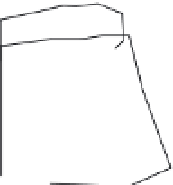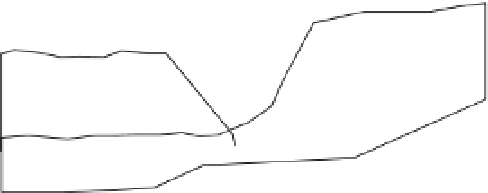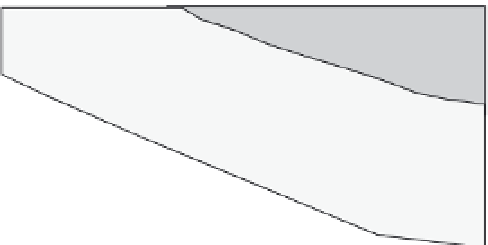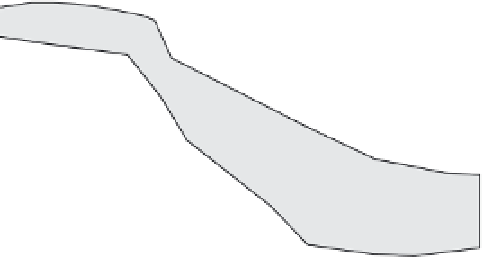Geology Reference
In-Depth Information
overlapping unconformity or the identification
of older offset unconformities can indicate both
the timing and magnitude of still earlier
earthquakes (Fig. 6.3A).
Topographic scarps created by faulting events
are rapidly “attacked” by erosional forces. If the
scarp forms in an area where active deposition
is occurring all around it, the scarp is likely to
be draped with younger strata soon after the
rupture (Fig. 6.4B and Plate 2E). If the scarp
forms in a predominantly erosional environ-
ment, its upthrown side will erode and will
commonly provide colluvial debris that accu-
mulates along the degrading scarp as a
colluvial
wedge
on the locally downthrown block
(Fig. 6.4C). During strike-slip earthquakes,
differential vertical motion is commonly small,
but movement along the irregularly shaped
fault plane will cause fissures to open in places
(Plate 2C). These fissures are open to the
surface and typically fill quite rapidly with
colluvial, alluvial, or eolian debris. In repeated
ruptures, fissures may reopen with each rupture
(Sieh
et al.
, 1989). Consequently, a single fissure
with multiple filling events may record several
different earthquakes (Fig. 6.5 and Plate 2C).
Seismic shaking can cause liquefaction of sedi-
ments having a high water content (Fig. 6.4F).
Liquefied sand represents a slurry of sand and
water that may be “erupted” on the surface to
form sand blows or sand volcanoes (Fig. 6.4E
and Plate 2A).
The interpretation of the stratigraphy and
structures found in trenching sites is often not
straightforward. In some fortunate circumstances,
clear cross-cutting relationships and abundant
material for dating are present (Fig. 6.6). At such
sites, ruptures of older strata and draping or
erosion across the upper termination of fault
strands provide direct evidence for faulting.
Even in these conditions, it is important to
remember that faults do not always propagate to
the surface and that new ruptures can form in
successive earthquakes. Thus, a newly formed
fault splay may branch out from the main
rupture and terminate at some random level in
the subsurface in an isolated outcrop or trench.
In this case, the undisturbed layers overlying the
fault termination will pre-date the faulting
Fissures
peat layers
b
event 3
overlapping
strata
a
b
event
2
event
1
b
fissure
margin
event 1
fissure filling
faults
0
30
60
90
cm
Fig. 6.5
Multiple fissure filling in successive
earthquakes.
Event 1 opened a fissure. The fissure filling post-dates the
event, contains some datable peat, and is overlain by peat
“a.” Event 2 reopens the fissure and cuts peat “a.” Event 2
is overlain by peat “b,” which draped the existing
topography and is cut along a small fault along the fissure
trend during event 3. Despite its complexity, this fissure
reveals the detail that can be extracted from a good
exposure and provides some insight into how
overlapping, cross-cutting, and fracture-filling relationships
can be exploited. Modified after Sieh
et al.
(1989).
event, which is the opposite of the case when
undisturbed layers depositionally overlie a fault
termination. Consequently, in evaluating fault
terminations, it is important to seek evidence
for: (i) surface erosion across the fault trace;
(ii) bed thickness changes above the fault
termination that indicate the filling of small-scale
topography related to the fault; (iii) discrete
groupings of the amounts of stratal offsets found
in older layers cut by the fault (indicating that
deposition was synchronous with faulting and
that previous earthquakes had occurred on the
fault); and (iv) significant displacement on the
fault just below the undisturbed layers, rather
than a progressive dying out of displacement




























































































































































